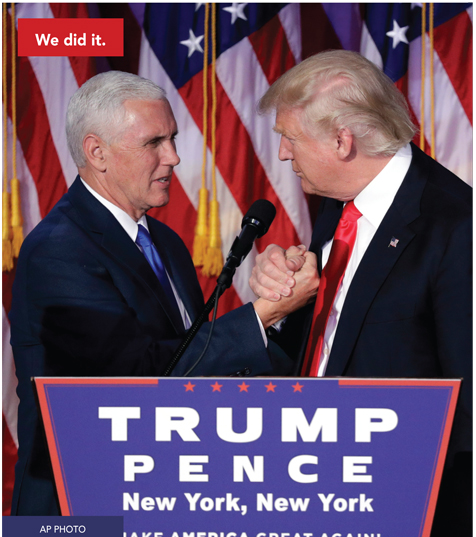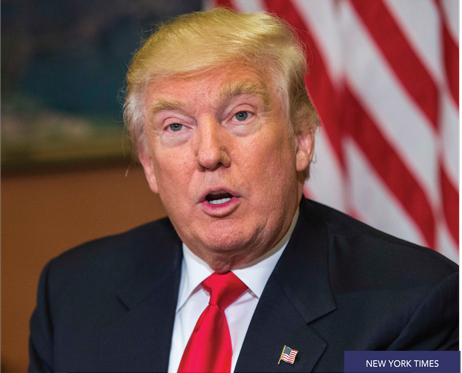In many ways, the story of Donald Trump’s election night triumph is a reprise of the equally unexpected 1980 victory of Ronald Reagan. Both Trump and Reagan were able to mobilize the growing anger and frustration of blue collar white workers who had long been the core voters of the Democrat Party, but whose interests have been abandoned by their elected leaders.
There are many parallels between the rises of Reagan and Trump. Both were Washington outsiders who had made their fame and fortune by pursuing other careers before responding to what they saw as a national crisis of leadership. They were initially ridiculed and denigrated by the political and media elites of their times, who saw them as unqualified for high office and warned that their unashamedly patriotic messages were dangerous to the country.
Blinded by their own prejudices and self-interests, the elites were unable to see that millions of long-neglected American voters were responding, first to Reagan and later to Trump, because they rejected the self-defeating policies of the liberal establishment and instead offered the confident and clear-eyed leadership the nation longed for and needed.
In many respects, the stunning success of Obama and the Democrats in the 2008 election sowed the seeds for the unexpected rise of Donald Trump. In the hubris of victory, Obama and Democrat congressional leaders made a crucial mistake. They assumed that they could permanently impose their ideological wish list upon the country simply because Republicans, for the time being, lacked sufficient votes in the House and Senate to stop them.
Obama and the Democrats told the American people that the $700 billion TARP bailout of the banks in 2008 would save the teetering financial system and that the $900 billion 2009 stimulus package would shock the economy out of its deep recession. But voters soon came to realize that while these measures saved Wall Street and the big banks from the threat of collapse due largely to their own financial irresponsibility, they provided Main Street and tens of millions of ordinary Americans with no relief for their suffering. The voters felt betrayed, and rightfully so.
The angry grass roots reaction to this betrayal gave rise to the so-called Tea Party movement. It was originally misinterpreted by most pundits and the media as a revolt by fiscal conservatives against the GOP establishment and its support for the compromised economic policies of the George W. Bush administration. But that was only part of the story.
Voters also began to openly rebel against the leadership of Obama and the Democrats when they realized that the unworkable Obamacare plan was being forced upon them by an administration that was trying to sell it to the public with misrepresentations and lies by the president himself, who told them repeatedly, “if you like your current insurance, you can keep it.” He also said the same thing about their favorite doctors.
DEMOCRATS WERE IN TROUBLE AND DIDN’T KNOW IT
Congressional Democrats did not realize how much political trouble they were in until they began meeting with their angry constituents. They were shocked by the harsh criticism from their supporters for backing Obamacare, as well as an expensive stimulus package which failed to create the new jobs and economic growth voters had been promised. Most of the stimulus money went instead to fund pet Democrat spending programs and the permanent expansion of federal welfare benefits. Instead of changing course, most elected Democrats accepted the assurances of the Obama White House and their congressional leaders that voter anger would blow over once they saw the benefits of Obamacare and the stimulus package.
However, those benefits never materialized. As a result, congressional Democrats were decimated in the 2010 midterm election. Voters elected a Republican majority in the House and reduced Democrat control over the Senate, with the expectation that the newly elected Republican legislators would begin dismantling the policies the American people had so overwhelmingly rejected. The Republican leadership failed to exercise its new political power and settled for political gridlock in Washington, perpetuating the unsatisfactory status quo.
In 2012, Republicans chose Mitt Romney, a decent man who turned out to be a weak presidential candidate who ran a terrible campaign that left Obama in power despite Obama’s low job approval ratings.
Nothing changed. Obamacare turned out to be the disaster that its critics had predicted, and the economy continued to limp along with the weakest recovery since World War II. In the 2014 midterm election, frustrated voters sent more Republicans to Congress and enabled them to take control of the Senate. But establishment GOP leaders still refused to act on their renewed mandate to challenge Obama and change his failed policies.
FURIOUS VOTERS
At that point, much of the American electorate was furious with the leaders of both parties, but those leaders remained largely oblivious to the public’s anger. They assumed that as long as they controlled the party organizations, voters would have no choice but to accept compliant mainstream candidates who would not “rock the boat” that party leaders would choose by manipulating the process behind closed doors. They were wrong.
The Democrat establishment had picked their 2016 presidential candidate even before Barack Obama entered the White House in 2009. They decided that it was to be Hillary Clinton’s turn. She was rewarded with the prestigious post of secretary of state for having accepted the humiliation of defeat for the 2008 nomination by a talented political unknown, and to burnish her already impressive Washington insider resume.
THE FIXED DEMOCRAT CONTEST
Potential Democrat challengers, such as Vice President Joe Biden and Massachusetts Senator Elizabeth Warren, were quietly warned off from mounting a bid for the nomination by party leaders well in advance of the start of the campaign. Meanwhile, the Democratic National Committee (DNC) set up a primary process designed to present Mrs. Clinton with the nomination after overcoming token opposition from lightweights like former Maryland governor Martin O’Malley and Senator Bernie Sanders of Vermont, whose socialist ideas were too far beyond the liberal Democrat consensus to be taken seriously, or so party leaders had believed.
On the Republican side, the most attractive candidates who had been elected to office with Tea Party support over the previous five years helped form an unusually large and diverse field of presidential candidates. The field also included some who seemed much less qualified than the former group, such as Donald Trump, a flamboyant Manhattan real estate developer and media personality. Trump had dabbled in national politics for several years. He had shifted from being a Republican to a Democrat to an Independent before returning to the GOP, but he had never before thrown his hat into the ring.
TRUMP WASN’T KIDDING
Initially, Trump’s candidacy was widely dismissed as a joke. His politically incorrect comments on illegal Mexican immigrants and his proposal to build a wall along the Mexican border to stop them were greeted with a mixture of derision and alarm by the other candidates in the field. A consensus quickly formed in the mainstream media and the political establishment that Trump’s candidacy would quickly implode, and the sooner, the better. Again, the political and media experts were wrong.
What many of Trump’s critics still don’t appreciate is that he knows more about the practical aspects of 21st century politics and the social media driving it than they do. Trump had quietly done his research before entering the race. His private polling showed him that there was a vast reservoir of repressed voter discontent with the political establishment that was waiting for someone like him who knew how to exploit it.
Trump totally outmaneuvered the professional Republican candidates who were arrayed against him, and beat his many critics in the mainstream media at their own game. Even some of the conservative commentators at Fox News and on talk radio who are lauding his victory today had raised serious doubts about his political qualifications and his character.
But this did not deter Trump. By remaining always provocative and available, Trump made his candidacy irresistible to the media because of the high ratings and advertising revenues that his unpaid appearances guaranteed. As a result, Trump garnered tens of millions of dollars worth of free media, largely on his own terms. Trump and the media simultaneously used and despised each other. By the time the media realized that it had helped to turn Trump into a political force it could no longer control, he had established his own unique national political brand which became self-sustaining.
Trump built on the huge pre-existing base of disgruntled Tea Party activists. Trump also quickly won the support of blue collar workers who viewed themselves as victims of an establishment system that was “rigged” against them. For decades, they were victimized by unfair trade practices which destroyed millions of their jobs and sapped the vitality out of the American economy. Trump validated their grievances that had been ignored for so long, and promised to serve as their voice.
MAKING AMERICA GREAT AGAIN
Trump’s goal to “Make America Great Again,” resonated with tens of millions of frustrated voters who had all but given up on their futures and the future of the country. It was the lowest common denominator of a diverse coalition which Trump built into a powerful nationwide movement. It was based on a unifying concept rather than specific policies, which shifted subtly over time in response to political necessity. It relied primarily on Trump’s charismatic personality and the unshakeable loyalty of his supporters as its driving forces.
On the Democrat side, Mrs. Clinton’s glaring personal deficiencies led her to commit unforced errors. They exposed her serious weaknesses as a political candidate, to the quiet dismay of many of her Democrat supporters and advocates in mainstream media.
The center-left policies which Mrs. Clinton publicly supported during her husband’s presidency and her eight years in the U.S. Senate had grown seriously out of touch with the steady leftward drift of the Democrat leadership since the 2000 election. This made the sincerity of Mrs. Clinton’s awkward efforts to embrace President Obama’s progressive agenda hard for the party’s left wing activists to accept at face value. They had serious doubts about her trustworthiness even before she was caught lying repeatedly about her unauthorized use of a private email server while she was secretary of state.
Her email lies confirmed their fears that once in power, Mrs. Clinton could not be trusted to keep her word to promote their progressive agenda, which was much more accurately represented by Bernie Sanders. They agreed with Sanders that the Washington political establishment had been corrupted by Wall Street and the big corporations. They also supported his populist proposals for the creation of new federal entitlements for health care and college education, to be paid for by punitive tax increases on the wealthy in order to finally make them “pay their fair share.”
THE UNEXPECTED SANDERS CHALLENGE
The unexpected surge of support for Sanders and its implied rejection of Clinton’s candidacy by the progressive core of Democrat activists came as a shock to party leaders and the DNC.
Mrs. Clinton’s candidacy proved to be surprisingly vulnerable to Sanders’ charges that she had sold out to Wall Street and big business interests. Recent WikiLeak disclosures of the emails of John Podesta, the chairman of Mrs. Clinton’s campaign, confirm that Mrs. Clinton was publicly telling voters one thing, and saying something very different in her private, highly paid speeches to bankers and big business executives.
The Sanders campaign also exposed a surprising weakness in Mrs. Clinton’s support from women voters, especially younger ones.
On April 27, more than a month before the primaries had ended, Trump accused Mrs. Clinton of playing the “women’s card” as her primary argument to persuade voters to support her. He said, “Frankly, if Hillary Clinton were a man, I don’t think she’d get 5 percent of the vote.”
From that point on to Election Day, Clinton’s accusations against Trump’s conduct with women became a major theme of her campaign.
Sanders’ popularity with Democrat primary and caucus voters pushed Mrs. Clinton far to the left on many issues on which she had long been on record supporting more moderate positions. This only increased her credibility problems with left wing Democrat voters. Because Clinton was unable to present voters with a coherent set of political positions that could survive a close comparison with her record, she and her campaign placed their emphasis on trying to disqualify Trump by claiming that he was temperamentally and morally unfit to serve as president.
CLINTON’S POLITICAL ALBATROSS
Throughout the campaign, from beginning to end, Mrs. Clinton was never able to escape the main political albatross which hung around her neck: her misuse of a private email server for classified information while she was secretary of state, which FBI Director James Comey condemned as “extremely reckless.” She compounded the problem with an unending series of lies she told to try to justify the existence of the server and explain how she used it, as well as her outrageous decision to delete half of the emails on it after they had been subpoenaed by a congressional committee.
Mrs. Clinton’s unbelievable explanations and excuses destroyed what was left of her credibility with all but her most devoted supporters. On July 5th, she narrowly escaped a criminal indictment, due to Comey’s reluctance to interfere directly in the selection of a major party’s presidential candidate, but closing the FBI investigation did not put the email server to rest as a major campaign issue. When new Clinton emails surprisingly resurfaced in the final weeks of the campaign, they broke the momentum of her campaign and reminded voters once again of the long Clinton family political history of questionable conduct and accusations of scandal.
Mrs. Clinton’s lame excuses for mishandling her emails were particularly hard to accept in light of her carefully cultivated reputation as a policy wonk who has long been obsessed with maintaining full control over the smallest detail. This made her claim of ignorance about the basic procedures for handling classified information and the government documents on her private email server even more unbelievable.
THE TAINT OF DISHONESTY AND CORRUPTION
The taint of dishonesty and corruption created by the email scandal extended to the Clinton Family Foundation, which was accused of offering a pay for play relationship to its major donors, enabling them to secure favors and special treatment from the Clinton-led State Department. Long before the existence of her private email server had come to light, Mrs. Clinton’s credibility came under attack due to her deliberate statements intended to mislead the American people about the terrorist nature of the 2012 terrorist attack on the U.S. consulate in Benghazi.
The fact that the mainstream media consistently downplayed the significance of Mrs. Clinton’s exposed lies about the mishandling of her emails and her actions before and after the attack on the consulate in Benghazi reinforced the impression that she was being judged by a different set of standards from everybody else in public life.
ABOVE THE LAW
Similarly, FBI Director Comey’s harsh condemnation of Clinton for mishandling classified information and his simultaneous refusal to recommend a criminal indictment reinforced the prevailing impression that even non-partisan government officials viewed Mrs. Clinton as being above the law. It was difficult to avoid the conclusion that Mrs. Clinton was being protected by the Obama administration because she had been the presumptive Democrat presidential nominee from the moment she stepped down as Obama’s secretary of state, two years before she formally announced her candidacy.
TRUMP’S UNIQUE CANDIDACY
The media and the political establishment never really understood the unique nature of Donald Trump’s candidacy. He was rewriting the playbook for conducting a successful presidential campaign from the moment he came down the escalator in Trump Tower on June 16, 2015 to announce that he was running.
Like Reagan, Trump was always much more interested in framing the broader goals of his presidency than the nitty-gritty details of the policies that would implement them. Like Reagan, Trump had a flair for the dramatic in his campaign announcements, and was prone to exaggerations to bring home his points to the American people that also drove the media fact-checkers crazy.
In Ronald Reagan’s 1976 campaign for the GOP nomination, he condemned abuses of the federal welfare system by citing the example of a “welfare queen” who lived in Chicago and defrauded the government out of hundreds of thousands of dollars. Such a woman did exist, and she was eventually brought to trial for her crimes, but Reagan’s critics were most upset at his unproven contention that such cases were so common that they discredited the federal welfare programs.
Similarly, in the early days of his campaign, Trump seized upon the well documented murders and other violent crimes committed by illegal immigrants who had been repeatedly deported and then allowed to re-enter the country. The true stories helped Trump illustrate the danger criminal aliens pose to ordinary American citizens and justify his call for building a wall along the Mexican border.
Trump’s leading initial opponent for the GOP nomination, former Florida governor Jeb Bush, as well as the mainstream media harshly condemned Trump for calling all Mexicans dangerous criminals, but Trump had never said that. In the meantime, Trump’s comments had succeeded in making his point on the illegal immigration issue which was paramount for millions of Americans living along the Mexican border. He also succeeded in dominating the headlines for news cycle after news cycle, occupying the media spotlight in a crowded Republican field.
TRUMP’S EVOLVING POSITIONS
Trump’s position on illegal immigration was to evolve substantially during the course of the campaign, along with details of his initial headline-generating promises to ban Muslims from visiting the U.S., to repeal and replace Obamacare, and others.
For most of Trump’s supporters, the changes in those details didn’t matter. They knew that first and foremost, Trump had committed himself to solving problems that they cared deeply about, and which had long been ignored by other candidates and elected officials. They were grateful that he had recognized and shared their concerns. His supporters also knew that while Trump was a successful businessman, he had no previous governing experience. They were therefore willing to trust Trump to keep his basic promises even if that meant modifying their details in order to eventually get it right.
By contrast, Trump’s political opponents and media critics jumped on every controversial statement he made during the campaign, and frequently sounded the alarm that his populist proposals and controversial statements of fact were demagogic and dangerous. They described many of his statements as “dog whistles,” implicitly appealing to the worst impulses of Trump’s followers. Yet at the same time, Trump’s opponents in the primary and general election campaign refused to acknowledge that he had identified problems of serious concern to tens of millions of American people, and simply dismissed them instead of engaging him in a serious discussion of possible solutions.
Hillary Clinton infamously libeled half of Trump supporters as “deplorables” and “irredeemable” bigots and racists. When criticized for saying that, Clinton pointedly refused to withdraw the accusation, and apologized only for applying the insult to a full 50% of Trump’s supporters.
TAKING TRUMP SERIOUSLY, BUT NOT LITERALLY
The crucial difference between the way that Trump’s supporters and opponents saw his proposals was best summarized by New York Post reporter Salena Zito, who wrote, following an interview with Trump in September, “The press takes him literally, but not seriously; his supporters take him seriously, but not literally.”
When Zito presented that concept to Trump, his immediate reaction was, “Now that’s interesting,” suggesting that it was a useful insight into how his message was being received.
Zito interviewed Trump in Pittsburgh, where he told industry executives attending the Shale Insight Conference about his “America First energy plan,” which would eliminate Obama administration environmental restrictions that had hobbled development of the huge, newly discovered domestic oil and gas reserves. Trump predicted his move would “unleash massive wealth for American workers and families.”
In March, Clinton told a town hall meeting in coal mining country that she was committed to destroying their source of livelihood to satisfy the ideological agenda of the radical global warming activists in her party.
Trump was harshly criticized by the nit-picking media fact checkers for saying, as part of his message to voters in minority inner city communities, that “Fifty-eight percent of black youth cannot get a job, cannot work,” and that he would do more to help them than the Democrat officials they have been reelecting for decades. On the campaign trail, he repeatedly asked minority voters, “What have you got to lose? I can fix it. The Democrats certainly haven’t.”
TRUMP’S SUCCESSFUL RUST BELT STRATEGY
Trump’s frequent campaign appearances in Pennsylvania and the other Rust Belt states of Michigan, Wisconsin and Minnesota were widely criticized by political pundits as a waste of Trump’s time and limited campaign resources. They rejected Trump’s accurate prediction, made soon after he first declared his candidacy, that his opposition to unfair free trade agreements would make him competitive in the Rust Belt states, flipping enough of them from Democrat to Republican to enable him to win a majority in the Electoral College.
Democrats scoffed at his claim. They cavalierly ignored those states, believing that their hold on Rust Belt voters was impregnable, until it was too late for them to counter Trump’s inroads.
Even though Trump’s Rust Belt surge was critical to his victory, it wasn’t the only fatal Democrat miscalculation.
This turned out to be a turnout election, not just in the Rust Belt, but also in several other crucial battleground states which Trump absolutely had to win in order to overcome the entrenched Democrat Electoral College advantage in recent presidential elections. These included Florida, Iowa, Ohio and North Carolina, while turning back Democrat challenges to the traditional Republican majorities in Arizona and Georgia. In the end, Trump’s working class and rural supporters came out to vote for him in disproportionately large numbers, while Clinton’s black vote in many battleground states fell below the totals racked up by Barack Obama in 2012. Trump somewhat exceeded pundit expectations for his support among Latino and college educated voters. But the demographic key to Trump’s victory was his support from blue collar working class and rural voters, which enabled him to overcome the large majorities that Clinton received in many urban areas.
Trump won by flipping the party vote in almost one-third of the 700 counties nationwide that Obama won in the 2008 and 2012 elections.
FIRST HINT OF A LONG NIGHT FOR DEMOCRATS
The first indication that overconfident Democrats were in for a long election night came shortly after the polls closed in Virginia. Trump jumped out to a surprise early lead, based on unanticipated strong support in the state’s rural southwest. Dramatic demographic changes in Washington DC’s southern suburbs had flipped Virginia from a Republican state to a reliably Democrat state in recent presidential elections. When the strongly pro-Clinton votes from those northern Virginia suburban counties finally came in, a few hours later, Democrats breathed a sigh of relief. But veteran political observers noted that her much narrower than expected victory in Virginia was a bad sign for the Clinton camp.
While the outcome in Virginia still hung in the balance, all eyes turned to North Carolina and Florida, which were seen as critical to Trump’s narrow path to winning a 270-vote or better majority in the Electoral College.
Trump won both states thanks to a massive turnout by rural voters and strong support in suburban areas, while Clinton’s urban and black majorities mostly underperformed the marks Obama set in 2012.
In North Carolina, 5% fewer blacks (91%) voted for Clinton than supported Obama (96%) in 2012. Overall black voter turnout was down to 19% of North Carolina voters from 23% in 2012.
TRUMP OVERPERFORMED WHILE CLINTON UNDERPERFORMED
Trump found a different formula for victory in Florida, with its large haul of 29 Electoral College votes. Democrats were confident that a strong pro-Clinton turnout by Latino voters angry at Trump’s immigration policies would give them the advantage. The Latino-augmented turnout in the traditionally pro-Democrat counties along the southeast coast was impressive, enabling Clinton to pile up a bigger lead there than Obama did in 2012. But Trump was able to overcome that lead with a massive voter turnout in the rural northern Florida counties, as well as stronger than expected support in the I-4 corridor across central Florida, including a surprise majority of voters in Pinellas County, which includes St. Petersburg. He won Florida with a 120,000-vote majority.
Trump won Ohio, with its 18 Electoral College votes, with an impressive 8% majority of more than 450,000 votes, despite the fact that the state’s Republican governor, John Kasich, publicly refused to support him and polls showed Clinton to be ahead in the state.
Later on election night, the same pattern of unexpected voter support for Trump, this time from working class voters, combined with Clinton significantly underperforming Obama’s 2012 margins of victory was repeated time and again across the Rust Belt, just as Trump had predicted.
In Philadelphia and its suburbs, Clinton racked up a big lead of 455,000 votes in the initial vote counts, but as a landslide of Trump votes came in from the rest of the state, her lead was gradually whittled down until it disappeared entirely, enabling Trump to carry the state by 68,000 votes.
Wisconsin was much closer, but Trump won because again, he swamped Clinton among rural voters who made up a little over a quarter of the state’s vote, while the black vote for Clinton in Milwaukee was down sharply from Obama’s majority in 2012. Trump’s victory in Wisconsin was particularly sweet for him, because the Never Trump movement led by Ted Cruz and Mitt Romney defeated him there in the April 5th primary, creating a brief crisis in Trump’s campaign. He was given little chance of winning the state and was mocked for traveling there to campaign in the final days of the campaign. But he sensed and saw something no one else did.
Trump’s triumphs in Pennsylvania, with 20 Electoral College votes, and in Wisconsin, with its 10 Electoral College votes, were enough to assure him the White House, because he had managed to hold all of the states Mitt Romney won in the 2012 election.
THE RETURN AND REVENGE OF THE REAGAN DEMOCRATS
Trump’s most historically significant victory came in Michigan, the birthplace of the legendary Reagan Democrats, where Democrats launched a frantic effort to hold the state in the final days of the campaign. After having largely ignored Michigan for most of the campaign, Clinton and her top surrogates, including the Obamas, crisscrossed the state in the days just before the election to plead with traditional Democrat voters to counter a late statewide Trump surge that had been reported by the media and confirmed by late polling.
Clinton emerged with a 290,000 vote lead from black voters in Detroit’s Wayne Country, as well as another 53,000 vote lead from neighboring Oakland County, but the most significant result came from historic Macomb County, which first defined the “Reagan Democrats” phenomenon.
After Reagan’s stunning 1980 upset victory over Jimmy Carter, Democrat pollster Stan Greenberg chose to study the voting patterns in the Detroit suburbs. Macomb County’s electorate was made up largely of unionized auto workers and their families who had been loyally voting Democratic since FDR first ran for president in 1932. In the 1960 election, John F. Kennedy carried Macomb County with 63% of the vote, but in 1980, voters unexpectedly changed sides.
According to Greenberg’s analysis, they no longer felt that Democrats were protecting their interests. Instead, these blue-collar voters saw their Democrat leaders working primarily on behalf of other groups, to their detriment. They saw their middle-class way of life and aspirations being put at risk, while Democrats took up the causes of the poor, feminists, the unemployed, blacks, Latinos, and other special interest groups.
They were also dismayed by Democrat President Jimmy Carter’s defeatist rhetoric about a “malaise” which had gripped the nation. Macomb County voters responded to Reagan’s strong appeal to their patriotic pride and confidence in their country and to his stimulative supply-side tax cutting policies that bolstered the manufacturing industries, which were crucial to their livelihoods.
These blue-collar workers turned the tables on their Democrat leaders who had, for so long, taken their votes for granted. Voters accepted Reagan’s claim that they had been betrayed by Democrats who no longer deserved their loyalty. As a result, 66% of the voters of Macomb County threw their support behind a Republican candidate for president, many for the first time in their lives, and a generation of Reagan Democrats was born.
“MORNING IN AMERICA” STRUCK A RESPONSIVE CHORD
They responded enthusiastically to the theme of Reagan’s 1984 campaign, that it was once again “morning in America.” They even remained loyal in 1988, supporting Reagan’s successor, George H.W. Bush, on the strength of his promise to remain true to Reagan’s conservative legacy. But Reagan Democrats turned against Bush when he showed them that he was just another Washington political insider with no real commitment to Reagan’s guiding conservative principles.
At the same time, a new generation of Democrats, led by a young governor from Arkansas named Bill Clinton, realized that the voters had firmly rejected the failed liberal policies of Lyndon Johnson and Jimmy Carter. The political future of the Democrats depended upon their ability to co-opt the issues that fueled Reagan’s success with more moderate versions of conservative ideas that camouflaged the Democrats’ liberal agenda.
BILL CLINTON ADOPTED REPUBLICAN ISSUES
The public’s rejection of a proposal crafted by Bill Clinton’s wife for a federalization of the American free-market medical system led to the historic Republican takeover of Congress in the 1994 midterm election. President Clinton then adopted a successful policy of “triangulation,” reaching pragmatic compromises with House Speaker Newt Gingrich which balanced the budget and rejuvenated the American economy.
Vice President Al Gore had been one of Clinton’s partners in forming the Democratic Leadership Council. The Council sought to reconnect with the working-class voters who had begun voting Republican in presidential campaigns, starting with Richard Nixon’s Silent Majority in 1968 and the Reagan Democrats in 1980. But Gore abandoned Clinton’s moderate approach when he ran for president in 2000 on an openly liberal platform. Gore and Democrat Party leaders sought to build a new liberal coalition consisting of ideological liberals and a variety of narrow special interest groups and minorities. In the process, they again turned their back on the needs of blue collar, white working class voters who had formed the backbone of the Democrat Party’s voter base since the Depression era, and forfeited their votes to the Republicans.
Barack Obama’s huge success in the 2008 election, and his ability to achieve re-election in 2012, convinced many Democrat leaders that they had created the winning coalition that had just barely escaped the grasp of Gore and his liberal successor, John Kerry.
OBAMA’S UNIQUE APPEAL
Obama’s rapid rise to national leadership in 2008 is now recognized as a unique political phenomenon rather than the start of a new national trend. Obama captured the allegiance of a new coalition of multicultural minorities, young voters and liberals. Even though Obama proved to be an ineffective party leader, Democrats were still confident that the coalition he assembled would assure their continued control of the White House and dominance of national politics for generations to come.
Only in the wake of their stunning loss last week have some Democrats begun realize their fatal mistake: that the enthusiastic support of Obama’s coalition was given to him alone. Excepting blacks and Latinos, Obama’s voters largely ignored his increasingly desperate appeals in the final days of this year’s campaign that they transfer their support from him to Hillary Clinton. She had committed herself to continuing Obama’s progressive policies once elected president, but she could never come close to duplicating Obama’s charisma and the enthusiasm he inspired in his supporters. As a result, the members of Obama’s coalition failed to return on Election Day in sufficient numbers to counter the nationwide groundswell of rural and working class support and enthusiasm that Trump created.
MACOMB COUNTY IS STILL THE BELLWEATHER
That failure was demonstrated by Trump’s success in flipping Macomb County, which voted for Obama by 63% in 2012. Macomb gave Trump 53% of its vote last week. In the end, Trump eked out a narrow 12,000 vote lead statewide in Michigan out of more than 4.5 million votes cast. Michigan and New Hampshire were the last states where the outcome of last week’s presidential election had not yet been officially declared almost a week after Election Day. Election officials were confident that Trump’s lead would hold up, giving him Michigan’s 16 Electoral College vote. Trump was widely expected to emerge with 306 Electoral College votes, 36 more than he needed to win the presidency.
The flip of Macomb County was by no means unique. Eleven other counties across Michigan which voted for Obama in 2012 went for Trump in this election. Thanks to the surge in blue collar and rural support for Trump across the Rust Belt, he was able to flip large cities such as LaCrosse and Racine, Wisconsin, and Erie, Pennsylvania.
Lackawana Country, which includes Scranton, Pennsylvania, which went for Obama by 63% in 2012, was a virtual tossup between Clinton and Trump.
Even though Clinton compiled a more than 200,00 vote lead in the nationwide popular vote, that is constitutionally meaningless and cold consolation, as Al Gore, who led George W. Bush by half a million votes nationwide in the 2000 election, could tell her.
Many disappointed Clinton supporters like to point out that Trump led Clinton in the critical Rust Belt states of Pennsylvania, Michigan and Wisconsin by a total of only 110,000 votes out of 121 million votes cast nationwide.
CONFUSION AND DESPAIR AMONG THE TALKING HEADS
By 11 p.m. on election night, as incoming vote counts made it clear that Trump was headed to a stunning upset victory, most mainstream media commentators were left in confusion and despair. They were unwilling to accept and unable to explain how they could have been so wrong about the clear decision of American voters to reject the experienced but untrustworthy Clinton and put their faith in brash outsider Trump.
At the CNN network, long known for its intensive election night coverage, its chief vote tracker, John King, stood at an electronic map for hours as the votes came in, showing viewers, county by county, how Clinton underperformed Obama four years ago, while Trump brought out record numbers of disaffected rural and blue collar voters.
A few days after the election, King concluded, “Every election teaches us lessons reminding us of truths we perhaps overlooked or simply ignored.”
Pointing to the final national map of presidential election results, King said, “If you look at all the little lines, more than 4,000 counties in the United States. See all that red? America is a center-right country. It is a lot more conservative, especially the heartland, than Democrats think.”
WHAT TOMORROW WILL BRING
Clinton’s defeat means that Obama is powerless to prevent President Trump from carrying out his promise to destroy much of Obama’s presidential legacy during his first day in office by simply canceling the executive orders Obama used to build that legacy in defiance of Republicans, who have controlled Congress for the past six years.
The angry street protests against Trump’s election and the growing recriminations within Democrat ranks are destined to fade as the reality of Trump’s oncoming presidency sinks in to those who are still in denial.
Idle conjecture and gloomy predictions about how Trump will actually govern and confront the nation’s domestic and foreign challenges will soon be replaced by his actual performance. Based on Trump’s early post-election statements and actions, he is likely to be far more responsible than his opponents had feared, and less confrontational than some of his supporters might hope.
Predicting the actions of a president-elect who takes such pride in remaining unpredictable means that we will just have to wait and see how Donald Trump’s highly unlikely presidency will unfold, and how the rest of the world will react. May Hashem guide this country’s next president to success.








